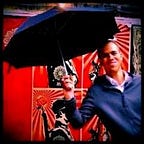Over the past few years, our societies have become increasingly divided on issues that directly impact our daily lives, such as Brexit, lockdown, and the monarchy. The methods we use to gauge public opinion, like opinion polls or referendums, often seem to amplify this division.
You can almost predict that each side will reinforce its arguments and oppose the other, with no room for discussion. Shortly after Brexit, I got involved in More in Common, an organisation that was set up shortly after Jo Cox MP’s death by a terrorist. It aimed to build bridges, and one of the activities was bringing together people who had voted for and against Brexit to find common ground.
It got me thinking that amidst all the new technology, many of the tools we use are created to find winners in debates…and, therefore, losers — instead of understanding each other. Of course, we have citizens’ assemblies or digital platforms for deliberation like Decidim, but what can we learn from our ancestors?
From our older generations, we can find the circle of life created by Native Americans, where people gather in a circle in an equal way. Everything in the circle of life is equal, and so should everyone’s issues. At the same time, Western culture brought people together at boardroom tables. The Cabinet of Ministers was named after the Prime Minister, who wanted to gather his top advisors in a small private room called a cabinetto in Italian.
The Native Americans also invented the burden basket, which allowed everyone to leave their troubles at the door before entering a discussion. There is also the talking stick, where people can ask to talk and have the stick to empower them rather than only one person having the stick or microphone.
The open-space method was created accidentally by someone who had planned a perfect agenda but then found people had more meaningful discussions during coffee breaks. He decided to create a way for people to decide what topics they would discuss and set up their own sessions, and anyone could come and go as they pleased — the law of two feet. These have now been adapted to the modern age into bar camps or unconferences.
The World Cafe method allows people to share their views on various subjects and mix up who they share them with, so everyone has time to have their say with different groups.
Future search is a similar mechanism in which people share their past, present, and future around issues to bring all the elephants in the room out of the closet and debate conflicting problems healthily. They are then asked to identify ideal futures and find and confirm the common ground they have agreed upon as a way to move forward.
Have you ever wondered what methods could be effective in helping people find common ground? What strategies have you personally used or come across that have shown promise in this regard?
Reflecting on your experiences, what valuable lessons have you learned about conflict resolution and community engagement? How have these insights shaped your approach to societal issues?
Considering the vast array of sectors and cultures, what unique approaches to conflict resolution and community engagement have you come across? How can we adapt and apply these strategies to our own societal issues?
